Rodents are characterized by a single pair of continuously growing incisors in each of the upper and lower jaws. Rodents are mammals; in fact, around 40% of all mammal species are rodents.
They are incredibly diverse. They can adapt to live in urban and suburban habitats; both inside your home or in your yard.
Whether inside or out, rodents can be some of the most destructive pests. Rodents are ambitious creatures that might try to claim your yard for themselves. They all go about that a bit differently, however. Below is a list of different rodents, and signs they might be slumming it on your land.
In this Article: Types of Rodents in Yard
Voles
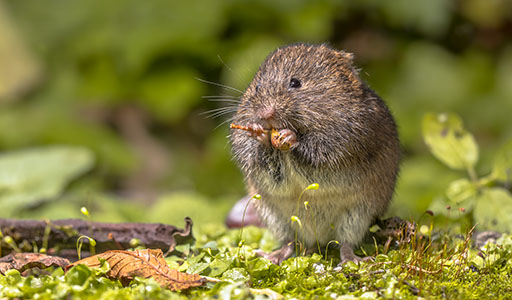
Voles are small rodents that are hamster-like in appearance, but with a blunt nose and stouter body. They are 3-9 inches long, depending on the species. Voles survive primarily on small plants, but can live off almost any fruit or nut. They will even resort to eating dead animals, when the going gets rough. Young voles grow very quickly, meaning that populations can explode.
Vole Range
In North America, voles range all the way from Alaska down to the mountains of Guatemala and Mexico.
When are Voles Active in your Yard?
Voles are active day and night, all year round.
Signs Vole Damage
- Tunnels. Voles don’t tunnel very deep; therefore, a sign of a vole infestation is seeing grassless depressions meandering around your yard that are about one to two inches wide.
- Crop damage. Voles feed on a wide variety of common garden vegetables including artichoke, brussels sprouts, beets, carrot, cabbage, cauliflower, spinach, sweet potato, tomato, and more.
- Tree damage. To keep their teeth from growing too long, voles gnaw around the trunks and roots of trees; this type of damage is called girdling. Gnaw marks are about 1/8 inch wide and 3/8 inch long. If voles gnaw completely around the trunk or roots, the tree becomes weakened or even dies.
Prairie Dogs
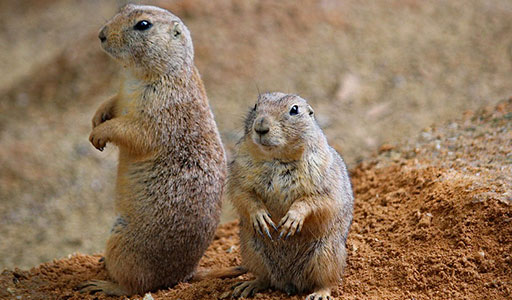
Prairie Dogs are herbivorous burrowing ground squirrels that live in the grasslands of North America, and are considered a keystone species there. Prairie dogs are stout bodied and grow to anywhere from 12 to 16 inches long, and weigh anywhere from one to three pounds.
Prairie Dog Range
In the US, prairie dogs are found primarily in the grasslands west of the Mississippi River.
When are Prairie Dogs Active in your Yard?
Prairie dogs are crepuscular, meaning they are most active at dawn and dusk. On warm, sunny days, prairie dogs may spend the whole day sleeping, and on some cool, overcast days, they might spend the entire day above ground.
Signs of Prairie Dog Damage
- Tunnels. Prairie dogs are tunneling creatures, meaning they grow expansive and elaborate systems of tunnels which are often bothersome to farmers.
Groundhogs
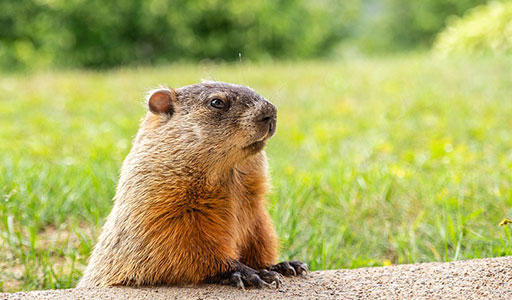
Groundhogs (also called woodchucks) are lowland creatures that are found throughout much of the Eastern US. They are the largest sciurid in their geographical range, measuring 16 to 27 inches in length, and weighing up 10 14 pounds.
Groundhog Range
Groundhogs are found only in North America, from Canada down to the Southern US.
When are Groundhogs Active in your Yard?
Groundhogs are diurnal, meaning they are active during the day. In winter, they hibernate. Most groundhog activity occurs in the early morning and early evening hours, when they emerge from their burrows to gather food.
Signs of Groundhog Damage
- Dirt holes/piles. Groundhogs are one of nature’s best excavators. They will often leave behind burrow holes and piles of dirt, especially near sheds or porches. These holes can be up to a foot wide.
Gophers
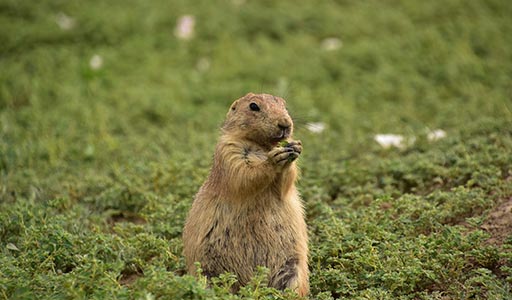
Pocket Gophers, or simply Gophers, are burrowing rodents that are endemic to North and Central America. On average, they weigh half a pound, and measure 6 to 8 inches in body length. Most gophers have brown fur that matches the soil of the area in which they live. They are called pocket gophers because they have pockets within their mouths that can be used to store food before they can store it in the chambers within their tunnel system.
Gopher Range
Gophers live all over the US, but the most prevalent species is the plains pocket gopher, which inhabits the great plains. Several other species live in the west and southeast.
When are Gophers Active in your Yard?
Gophers don’t hibernate, and can be active at any hour, day or night.
Signs of Gopher Damage
- Dirt Mounds. Gophers make dirt mounds during the tunneling process, when they discard excess soil aboveground.
- Damaged Vegetation. Gophers feed on many garden crops, ornamentals, vines, shrubs, and trees. Sometimes they pull entire plants down into their tunnels.
Chipmunks
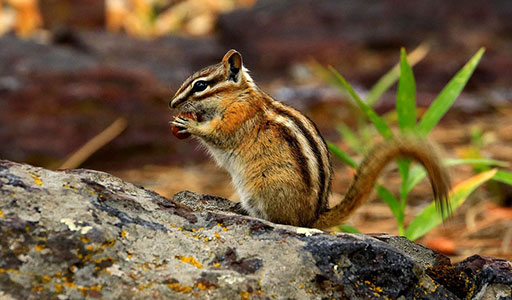
Chipmunks are small, striped rodents. They are 8 to 10 inches long, and weigh between 2 and 5 ounces.
Chipmunk Range
Chipmunks are found throughout the eastern United States, west to the Mississippi River and in southeastern Canada.
When are Chipmunks Active in Your Yard?
Chipmunks are most active in the early morning and late afternoon in the spring, summer, and fall months. In winter they retreat to their burrows and experience a state of torpor.
Signs of Chipmunk Damage
- Holes in the ground. Holes dug by burrowing chipmunks are 2-3 inches in diameter, with no dirt next to them.
- Uprooted plant bulbs. Chipmunks love snacking on flowering bulbs.
- Holes eaten out of low-hanging vegetables (especially tomatoes). Chipmunks often get water this way during a dry spell.
Beavers
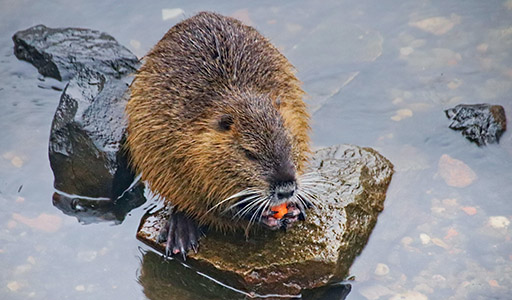
Beavers are the largest living rodents in North America, with adults averaging 40 pounds in weight and measuring more than 3 feet in length, including the tail.
Beaver Range
Beavers are found throughout North America with the exception of the California and Nevada deserts and parts of Utah and Arizona.
When are Beavers Active?
Beavers are active from dusk to dawn.
Signs of Beaver Damage
- Dams. Beavers are innately driven to construct dams, which resemble a brush pile in the water.
- Gnaw marks on trees. This is indicative of beavers especially if the marks are on the side of the tree that faces the water.
Muskrats
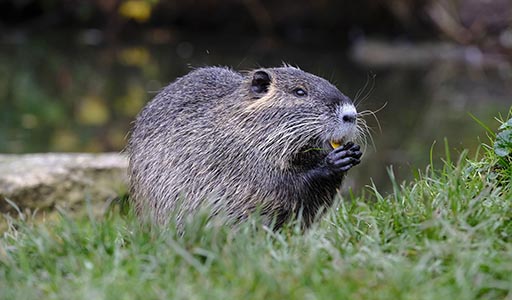
Muskrats are large amphibious rodents indigenous to North America. They are quite robust, weighing up to 4 pounds, and measuring up to 13 inches long.
Muskrat Range
The muskrat’s geographic range covers most of North America south of the Alaskan tundra to Newfoundland into the southern US.
When are Muskrats Active?
Muskrats are active all year round, and feed at all times of the day, mostly at night.
Signs of Muskrat Damage
- Chew marks on trees. Stripped bark is also possible.
- Partially eaten crop stalks. They may also eat the stalks of wetland vegetation, such as water lilies.
- Bank erosion/cave ins. This is due to the muskrat’s burrowing.
Norway Rat
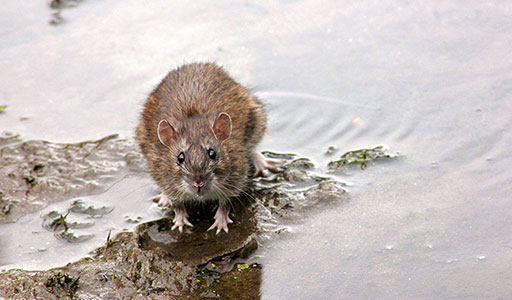
Also called the brown rat, this is the most prevalent—and infamous—rat in the USA. They are large, growing to around 16 inches long (tail included—their bodies are around 9.5 inches), with males typically weighing around 1.25 pounds. Norway rats only require about an ounce of food and water each day to survive.
Norway Rat Range
Native to northern China, the Norway rat is found in every state in the US.
When are Norway Rats Active?
The Norway rat is usually nocturnal
Signs of Norway Rats Damage
- Burrows Norway rats usually construct nests in below-ground burrows or at ground level.
- Runways Worn down vegetation under rocks or wood piles and near garbage cans.
- Rat droppings Small, dark colored droppings with blunt ends
- Graw marks Graw marks especially on wood or garden vegetables.
How to Get Rid of Rodents in Your Yard
In addition to the regular annoyances, many of the rodents on this list can burrow under your house, which can cause a whole host of structural problems. As such, it’s important to deal with them promptly.
While you might be able to handle the issue on your own, rodents can be aggressive and carry diseases, so we highly recommend contacting Trutech Wildlife to assess and address the situation.


